Presentazione. "People Health Engagement": fra mainstream e nuovo paradigma
Journal title PSICOLOGIA DELLA SALUTE
Author/s Claudio Albino Bosio, Guendalina Graffigna
Publishing Year 2014 Issue 2014/3
Language Italian Pages 6 P. 5-10 File size 39 KB
DOI 10.3280/PDS2014-003001
DOI is like a bar code for intellectual property: to have more infomation
click here
Below, you can see the article first page
If you want to buy this article in PDF format, you can do it, following the instructions to buy download credits

FrancoAngeli is member of Publishers International Linking Association, Inc (PILA), a not-for-profit association which run the CrossRef service enabling links to and from online scholarly content.
- Integrating Technology in Positive Psychology Practice Serena Barello, Julia Menichetti, Guendalina Graffigna, pp.59 (ISBN:9781466699861)
- Health Care Delivery and Clinical Science Serena Barello, Julia Menichetti, Guendalina Graffigna, pp.62 (ISBN:9781522539261)
Claudio Albino Bosio, Guendalina Graffigna, Presentazione. "People Health Engagement": fra mainstream e nuovo paradigma in "PSICOLOGIA DELLA SALUTE" 3/2014, pp 5-10, DOI: 10.3280/PDS2014-003001